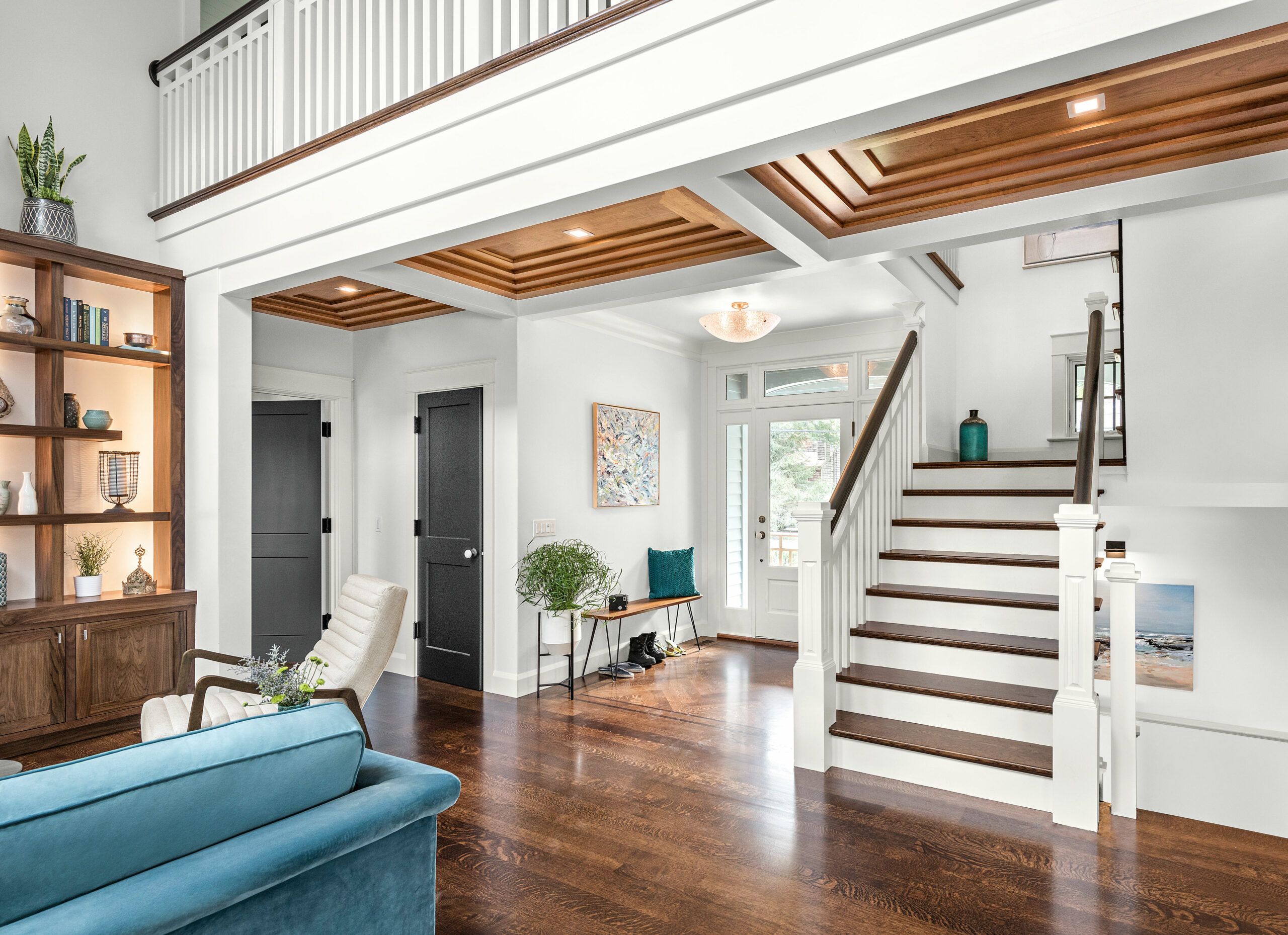Entryways and mudrooms are transitional spaces where your residents and guests can shrug off their backpacks and remove their messy shoes. They can also be catchalls for hats, coats, pet leashes, and sports equipment. Some thoughtful design and organization can make these spaces more than just messy storage areas.
Key Elements of Efficient Entryways and Mudrooms
Different households need different things from their entryways and mudrooms. For example, families with young children may need more storage compared to an entryway in an empty-nester’s house. However, both will benefit from common features that reduce clutter and make the space more welcoming.
Seating
Having someplace to sit while putting on or taking off your shoes is always nice. A bench or well-placed chair will help keep family members from traipsing through the house and tracking in dirt and mud.
Storage for Coats
A nearby entry closet usually serves as the dropoff spot for coats and boots in a narrow entryway. However, this isn’t quite enough space for a larger family, who could benefit more from the built-in coat and shoe cubicles, wall hooks, and shelves of a mudroom.
Storage for Incidentals
Every household has those small, everyday items that tend to get misplaced—keys, mail, dog leashes, and more. Designating specific spots for them in your entryway or mudroom can save time and reduce stress. A small bowl or tray for keys, a wall-mounted mail sorter, or leash hooks can keep these items easily accessible and organized. Consider using vertical space with wall-mounted organizers in compact entryways to maximize storage without taking up floor space.
Sinks and Laundry Areas
While sinks and laundry areas aren’t an option for small entryways or main entrances, it makes good sense to incorporate them into mudrooms. That way, you won’t have to haul wet socks and gym clothes across your house. Powder rooms directly off the mudroom are another popular idea since they allow people to wash their hands before continuing to the rest of the house.
Designing Your Perfect Entryway
Images of attractive mudrooms and entryways abound online and in home improvement magazines, and it’s only natural to spot one you love and want to copy. But for your project to succeed, it has to suit your family’s specific needs. No matter what type of space you have to work with, spending some time in the design and planning phase is a good idea.
Zeroing In on Function
Figure out the functional details first. Will every family member need their own space for coats, hats, and shoes, and do you want to add storage for sports equipment? If small children or mobility-restricted people will use the space, you may also want to incorporate low-height access to storage compartments or a wider ADA-compliant doorway.
Choosing the Right Flooring
Entryway and mudroom flooring face heavy foot traffic and exposure to water and dirt. This isn’t the place for fancy rugs or hardwood floors. Instead, try options like ceramic tile, porcelain, luxury vinyl, or even stone if your budget allows. To keep the floor from feeling too hard or cold, you can add an indoor/outdoor rug to shake off or spray down outside.
Adding Functional Furniture
In addition to style, entryway furniture must also be functional. A small table or shelf can hold essentials like keys and mail. Furniture with built-in storage, such as benches with drawers, cabinets, or shoe racks, helps keep the area tidy.
Family-Friendly Features
To make your mudroom work for the whole family, consider assigning individual storage spaces for each family member. This could include personalized lockers, cubbies, or hooks labeled with names or photos. For families with young children, include low storage options that are easily accessible. A bulletin board or chalkboard can serve as a family message center, helping to keep everyone organized and informed.
Remodeling To Add a Mudroom
If your home doesn’t have a dedicated mudroom, you might be able to add one through remodeling. There are four main options, and the best one will depend on your home’s layout and specific needs.
Building an Addition
Building a mudroom addition gives you the most design and feature flexibility. However, it’s also the most complex and expensive option, typically requiring the help of a professional contractor so everything adheres to local codes.
Converting Existing Space
Every home’s layout is different, but if your home has an enclosed, climate-controlled porch, it can double as a mudroom. Consider covering the siding with painted beadboard and then adding benches and built-in lockers and shelves. The best part about a mud-porch conversion is that it can be a DIY project for homeowners with basic carpentry skills and a few power tools, such as a circular saw and a nail gun.
Expanding Interior Floor Plans
Many older homes have large, rambling floor plans, and if a pantry, in-kitchen dining area, or large laundry room is just inside a back or side door, you could convert it to a mudroom. If you need to remove interior walls or install new wiring and plumbing, it’s best to leave the job to the pros.
Converting Attached Garage Space
Converting a portion of an attached garage into a mudroom can be an excellent use of space. While this can be a DIY project for an enthusiastic homeowner who knows framing, you’ll need to install a new fire-rated wall and exterior door between the garage and the mudroom. Check with your local building authority for the regulations you must follow.

